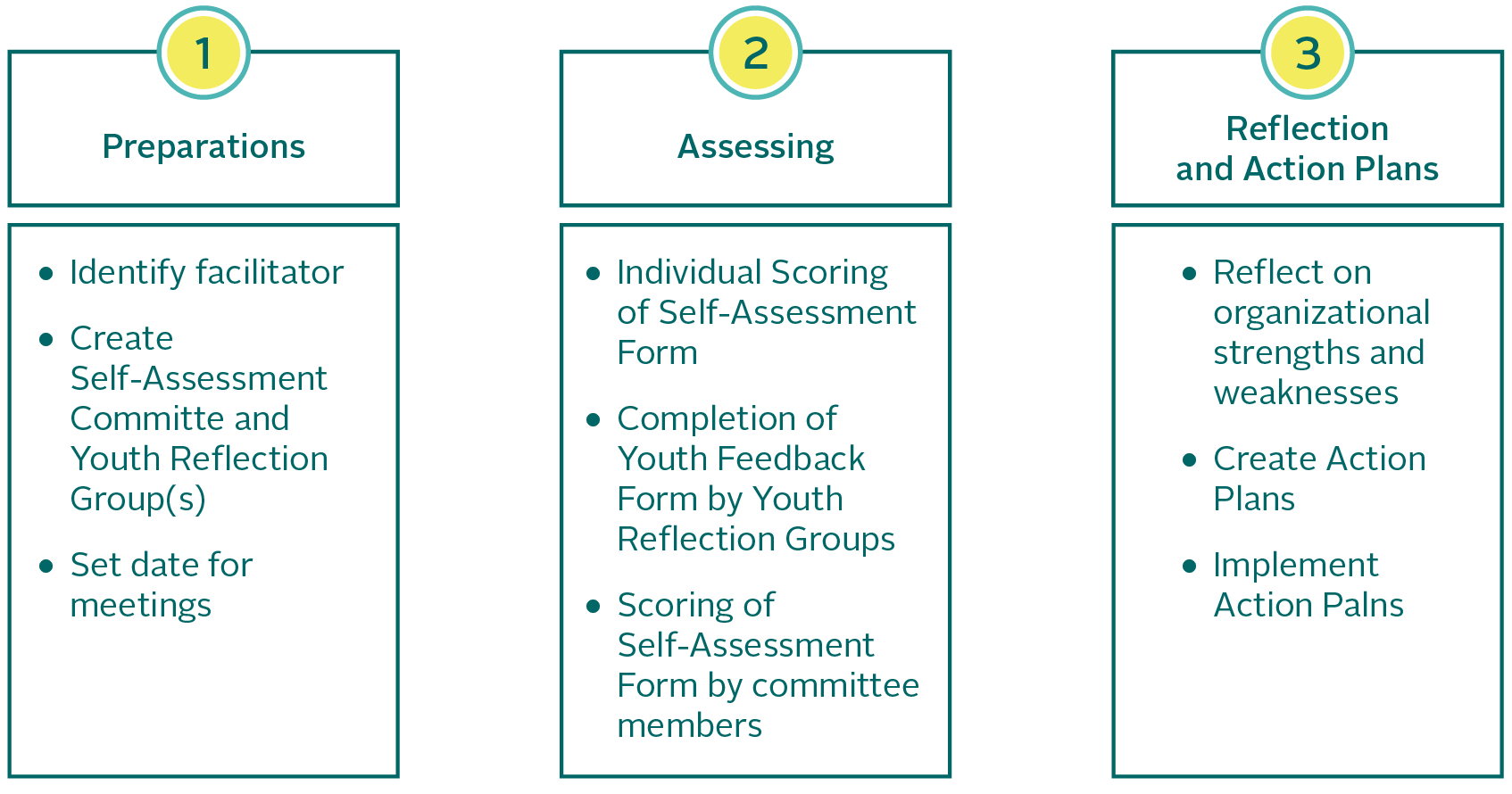What are the steps?
The YPAT is primarily informed by USAID’s YouthPower Positive Youth Development (PYD) framework and approach to youth programming.
The YPAT includes three phases: Preparation, Assessing, and Reflection and Action Plans. Broadly, Phase 1 consists of preparatory activities for the assessment; Phase 2 refers to the different sub-steps involved the scoring process; and finally, Phase 3 is about reflecting on the results of the scoring process to generate implementable action plan.

What is the process?
Below is an overview of the steps for completing the YPAT. For more details on each step, please read the implementation guide (if you are an organization assessing your programming) or the facilitator guide (if you are facilitating the assessment process).
1Identify a Facilitator
The facilitator will be responsible for reading through the tool in its entirety, with special focus on the Assessment Form and determining if any adaptations are required due to the organization’s needs and/or context. While it is recommended that the organization find an external facilitator, it is possible to use an internal facilitator as long as he/she is not directly involved in the programming being assessed.
Create Youth Reflection Group(s) and Assessment Committee
Identify youth for Youth Reflection Groups: The facilitator will convene 5–10 current or recent youth program participants for each Youth Reflection Group(s).
Identify participants for the Assessment Committee: We recommend that the Assessment Form be completed in a participatory manner by an Assessment Committee comprising 5–8 members. As the participatory assessment approach is aimed at combining multiple perspectives we suggest committee members represent the program’s leadership, management staff, program staff involved in program delivery, and at least two participants from the Youth Reflection Groups. When choosing committee members, try to obtain a diverse group in terms of gender, age, and background.
Set date for Youth Reflection Group and Assessment meetings
The facilitator should discuss potential dates with selected committee members and Youth Reflection Group participants. We recommend that the committee plan to have the Youth Feedback Form completed prior to the Assessment Form. When choosing the date and time for conducting both the Assessment Form and the Youth Feedback Form, make sure to consider youth’s availability.
Individual scoring
The facilitator should send the Assessment form to committee members at least one week prior to the meeting. Members of the Assessment committee should first complete the Assessment Form individually.
Completion of Youth Feedback Form in Youth Reflection Groups
Youth engagement in the Assessment will follow a two-stage process: 1) completion of Youth Feedback Form in Youth Reflection Groups, followed by 2) participation of selected youth representatives in the Assessment Committee.
Stage One: Youth Reflection Group participants will complete the Youth Feedback Form, which captures youth experiences and perceptions of key standards. The questions are directly related to many of the standards in the full Assessment Form but have been re-worded to better gather youth perceptions.
Stage Two: Two or more youth representatives from the Youth Reflection Groups will participate in the Assessment committee and present the views, opinions, suggestions that arose from the group reflections.
Scoring by Assessment Committee
Once all members of the Assessment Committee have individually completed the Assessment Form, the facilitator will convene a committee meeting. During the meeting, the facilitator or other committee member reads aloud each standard as well as the description and examples associated with each performance level, and the committee will determine a score. The score should be entered into the Scoring Grid, which will help populate an overall score for each section.
Reflection and Action Plan
The Assessment committee will look at the results in the Scoring Grid and reflect upon it as a team. Based on the assessment results, the facilitator will guide the organization through developing an Action Plan that outlines the agreed upon actions, roles, and timeline for areas they wish to improve. Be sure to include youth from the reflection groups as part of this action planning process; involve them in prioritizing actions and in identifying youth roles and responsibilities for carrying out the action plans.
